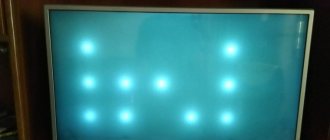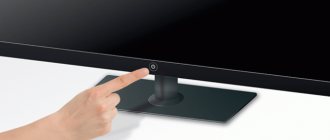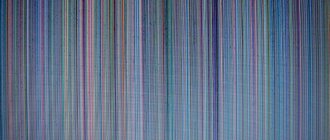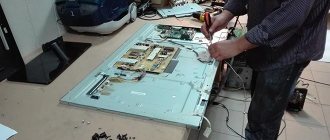Characteristic dark or light spots appear on the TV screen if the matrix, diffuser or backlight elements are damaged. Also, dark spots can appear as “dead” pixels - interestingly, a certain number of them is sometimes expected during assembly, and there is even a method for standardizing LCD screens by the number of expected “dead” pixels, from 0 to 50 per 1 million in the matrix .
Let's take a look at how exactly such spots appear, how to use equipment to avoid their appearance, and what to do if they do appear.
Manifestation of malfunction
Often a dark spot appears on the screens of LCD TVs, even from proven and popular Samsung, Sony, and LG brands. They can be localized in one corner, located in the center, or in several places at once.
The spots do not disappear when changing channels. Even when the TV is turned off, glare is visible in their place. Moreover, the darkening can be not only black or dark gray, but also white or colored. This indicates color errors or other problems.
Causes of dark spots
- Manufacturing defects. It is quite rare and appears immediately. The reason is a violation of the assembly technology, leading to damage to the display matrix. Such a malfunction must be repaired by service center specialists under warranty free of charge. And in order not to buy a bad TV, you need to carefully inspect the equipment in the store.
- Mechanical damage. An especially common reason is when there are children in the house playing with a ball in the apartment. A strong blow or pressure leads to the appearance of spots on the kinescope. Dead (broken) pixels first appear in the affected area, then spread across the screen.
- Moisture or air getting under the protective glass. The reason is poor transportation or improper care. Do not wipe the monitor with water or a heavily dampened cloth.
- Effect of high temperature. The presence of a heat source near the device leads to various problems, including the appearance of yellow spots due to matrix delamination.
- Dust getting under the housing. If you do not properly care for your household appliances, one small black dot can develop into a large dark spot, which only service center (service center) technicians can eliminate.
Equipment repair depends on the source of the stain and the type of equipment.
Reasons for appearance
Spots on a liquid crystal (LCD) monitor or TV most often appear during the operation of the equipment. Not a single screen, even from the most expensive company, is immune from such a problem. The main reason for such errors is considered to be manufacturing defects.
But the spots are different. It happens that when watching TV in some places on the screen (if there is a certain color in some area) you can see barely noticeable white highlights.
This situation can happen with any LCD, LED or plasma screen. But do not rush to sound the alarm, such an image may be a feature of this model, and not its defect.
In rare cases, such "spots" are a design feature. These may also include thin stripes along the edges of the screens that are a couple of tones lighter than the rest of the surface. Some people who are not experienced in good images may not notice such defects for years, but a picky user will immediately detect them. In other cases, such spots may appear during operation of the TV, and each type of screen may have its own reasons for their appearance.
LCD and LED screens
The reason for the appearance of white areas on this type of screen may be:
- incorrect assembly of the device - if the matrix is installed skewed, then similar defects may appear;
- physical impact on the surface of the screen (pressing or hitting it).
In any of the described cases, you will have to completely change the matrix.
Plasma
A plasma panel also has such shortcomings, only here the problem lies in the malfunction of the blocks that are responsible for constructing the picture. In rare cases, this may be a defect in the matrix itself. To fix this problem, you will need to replace the image building unit.
As soon as you notice problems with the image, and if the warranty period has not yet expired, it is advisable to immediately send the product to a service center for repair or replacement. It is worth noting that sometimes very small and not very noticeable stains cannot always be regarded as a warranty case and repairs will be refused.
Why do spots appear on the screen?
The outer side of the screen of a modern LCD TV - the matrix - consists of layers of polymer materials of various types: several layers of polarizer; glass or glass substitute; layers of material coated with liquid crystals; anti-glare coating. Behind the matrix there are several more layers of similar plates - diffusers, behind which there are light sources.
Let us make a reservation that the article will consider cases in which a dark or light spot appeared on the screen of a recently “healthy” TV. If you just unpacked and installed the device, turned it on for the first time and already see a “dead” zone on the screen, run headlong back to the store and get a replacement. Physical damage received during transportation and legal areas, but, as a rule, if you are absolutely sure that the damage was caused by the fault of the store, insist on an examination: by default it is carried out at the expense of pixels
Conventionally, this problem can be divided into two more subtypes: working pixels showing the wrong color, and completely “dead”, black areas.
A completely black pixel that does not respond to touch (that is, is not another type of black spot, which we will look at below) means that the transistor responsible for controlling that part of the screen has burned out. You'll either have to put up with the black dot or take the TV in for repair. Find out if repair is possible under warranty - the chances are small, but in high-end matrices the presence of dead pixels is unacceptable. Unfortunately, there are surprisingly few of these on sale, and for the rest this is not a warranty case - and the matrix standard is often omitted in the TV specifications available to the consumer.
You can try to cure incorrectly colored (“stuck”) pixels yourself. The culprit of the problem is voltage fluctuations, as well as extreme (usually very high) temperatures, which can cause the liquid crystal to “hang” in the wrong position. This becomes especially noticeable after the TV has been on for a long time.
Unlike the previous defect, this type of “broken” pixel can, in its own way, “infect” its surroundings - over time, you will see that the problem spreads to neighboring pixels, and gradually it can turn into a fairly noticeable stripe along the screen.
The first thing to do is reduce the temperature exposure. Do not cover the TV with a heavy cloth, move it away from heaters, radiators and, if possible, from direct sunlight.
There are special utilities, the use of which can help fix a malfunctioning pixel. The principle of their operation is to pass different colors through each pixel of the screen. As a rule, such programs are played for many hours without stopping.
Occasionally, “massaging” a dead pixel can help. Note to yourself the damaged area on the screen, turn off the TV and for a minute or two, gently press with a dry cotton swab where the frozen pixel is located. Wait another 10–15 minutes, then turn on the TV and check the problem area - the frozen pixel may return to normal.
Most often, the option of cooling the device helps. Unplug the TV and place it in a cool, dry place for a few hours - for example, clearing a spot on the balcony on a winter night. Cooling causes the liquid crystals to solidify, rigidly aligning their orientation. By returning to normal temperature, they will return to their default state, free of spatial defects.
After being in the cold, streaks may be visible on the screen - let the device work for a few hours and they will disappear.
IMPORTANT. In plasma TVs, pixels are arranged a little differently - and an incorrectly lit pixel can also mean an “incurably” burnt out transistor.
Black spots with clear edges or black stripes that disappear with pressure
Such black spots on the TV screen may also look like a kind of “crack” that appears after an impact or fall from a height. Gently run a clean finger over the damaged surface, pressing slightly: a real crack will be raised to the touch and will not disappear from pressure. We have a separate article about why cracks suddenly appear on the screen and how they can be corrected.
If the problem disappears when pressed and appears again, as soon as you remove your hand, we are dealing with depressurization (delamination) of the matrix layers. This is due to the penetration of moisture and air into the matrix - and sometimes this can be triggered by even a small speck of dust that accidentally ends up between the layers.
Grayish spots with clear edges that do not cover the image (but are noticeable against its background) usually indicate a defect in the polarizer - if you carry out an examination, you can get the screen replaced under warranty.
Dark spots with blurred edges
Such spots usually appear around the perimeter of the screen and make the screen look like a billboard illuminated at night - the spots are cone-shaped, without clear edges and look like a “blackout” of part of the screen. Usually this is the case - this is a sign that part of the backlight located behind the matrix has failed.
Dark spots of irregular shape with blurred edges that appear in the center of the screen may indicate defective (or delamination) of the diffuser films.
Light spots with blurred edges
Such light spots on the TV screen often appear several at a time, have a regular shape and look as if someone is shining a flashlight through the screen from the inside. As a rule, this means a defect (or delamination) of the diffuser or reflector film, or failure of the LED lenses. The defect usually appears after the TV has been in operation for a long time or under the influence of heat.
Blue or purple spots
A purple spot on the TV screen appears when the LED is faulty - most likely, you will have to change the backlight panel. Typically, bright purple or blue light appears first at the corners of the screen.
Light spots with clear edges
White spots on the TV screen, covering the image, indicate delamination of the matrix - similar to black ones, but the second polarizing film is peeling off. Perhaps one or more matrix connection cables are faulty.
Multi-colored (rainbow) spots
Colored spots on the screen mean that the main board of your TV has probably failed. You'll have to take it in for repairs - fortunately, this board can be repaired relatively bloodlessly. For CRT TVs, such a defect usually means magnetization of the screen or a faulty posistor.
Why do spots appear on the screen?
First, let's look at the general problems that are common to all modern TV equipment, regardless of its type. Fortunately, there are much fewer of them than on old analog TVs, because only one element, although quite complex, is responsible for correct visualization - the matrix.
Manufacturing defects
This is true not only of budget models, but even of premium models from famous brands – Samsung, LG, Philips and others.
Advice! The only option to avoid manufacturing defects is to carefully check the equipment at the time of purchase.
Almost every firmware has special software - grids aimed at identifying dead pixels (black and white dots), spots and other defects. If a manufacturing defect was discovered at home when purchasing through an online store, the seller is in any case obliged to replace the product.
Physical damage
Pressing or hitting the TV screen hard may cause colored spots to appear. Moreover, dead pixels can spread to the rest of the matrix, which is typical for budget models where there is no independent protection for each sector. This kind of damage excludes any repairs - only matrix replacement.
Moisture and air getting into the matrix
This may involve a violation of transportation rules by the seller or improper operation of the equipment by the user. Even a few drops of water or dust particles that get into the body of the matrix can cause unpleasant spots to appear on the LCD TV screen.
High temperatures
If there is a heater or other strong heat source near the TV equipment, then the matrix may delaminate in LCD devices, or even stop working altogether if it is a plasma panel . In this case, small highlights appear that gradually fill the entire screen space.
The shape and color of the spots can also tell a lot about the nature of the problem, which allows you to immediately begin solving it. For example, on old analog TVs, multi-colored spots indicate excessive magnetization of the screen. To eliminate this problem, simply move the device to another place, away from electromagnetic equipment affecting it.
Yellow spots indicate that the process of matrix delamination has already begun, which is typical for budget models that have been actively used for more than 5 years. More expensive TV equipment for the most part does not have such problems.
Methods for dealing with glare=”subtitle”>
As already mentioned, it will not be possible to completely get rid of glare, but reducing it to a minimum is a completely possible and solvable task. You need to use a few simple tips:
- changing screen brightness and contrast settings. To obtain a brighter and richer picture, most monitors and televisions are factory set to higher brightness and contrast settings. Reducing their values can significantly reduce the unpleasant effect of clouding;
- change in room illumination. As a rule, highlights appear when viewing dark scenes in a dark room. Turning on a floor lamp, night light or table lamp can, in principle, solve the problem with their appearance;
- using a preset profile. Most TVs have several built-in picture brightness profiles. One of these is “Kino” (it may have a different name from different manufacturers). The essence of its use is that when the “Cinema” mode is activated, the glow of the upper and lower rows of LED backlight strips is somewhat muted, thereby creating the atmosphere of a cinema. Typically, the highlights also become less pronounced or disappear altogether;
- use of background lighting. Using a backlight on the back of the TV, as with ambient lighting, can mask unwanted artifacts that appear in the image;
- Unscrewing the back cover screws. Sometimes an overly tightened lid leads to slight physical deformation of the matrix, which in turn provokes the appearance of glare. Unscrewing the screws 1-2 turns relieves tension from the TV case and can significantly improve the situation with their appearance;
Be extremely careful - in many models, loosening the cover screws yourself will void the warranty! Use the services of service centers.
- “massage” the screen. According to statistics, it helps very rarely, and then, more often with dead pixels, and not with glare, if the reason for the appearance of artifacts is really the warping of the elements that make up the “pie” of the screen. The procedure requires any soft tissue and patience. On a screen with black fill turned on, highlights appear to be smoothed out away from the center of the bright area.
When carrying out “massage” procedures, you need to be extremely careful; you do not need to apply excessive effort or pressure on the screen. This way you can “kill” the matrix completely.
To radically resolve the issue with clouding, you can try your luck at a service center to obtain warranty repairs. But since it is known that the manufacturer does not consider this phenomenon to be a defect, the hope of receiving warranty service is extremely vague. Everything will depend on the arrangement of stars in the sky and the goodwill of the service workers.
Highlights that appear on colors other than black have a much greater chance of being eliminated under warranty. In this case, repairs should not be asked, but demanded! There is an obvious factory defect.
When you can’t do without repairs=”subtitle”>
It is much worse when, instead of cloudy lights, there are bright, clear points of light on the screen.
This suggests that the optical dividers of the backlight LEDs came unstuck and fell off under the influence of high temperatures. For this reason, the light is not scattered, but hits a powerful beam directly through the layers of the matrix.
This problem can only be eliminated in a workshop, by replacing either the entire LED assembly or by replacing a damaged light source.
Some Kulibins offer to glue the fallen dividers back into place, but the prospects for such repairs are doubtful. The fact is that positioning the divider on the LED crystal is a very important and highly precise operation, and doing it “on the knee” is quite problematic. The best option is replacement.
This repair is clearly recognized as a warranty, therefore, if a defect occurs during the warranty period, it will be eliminated at the manufacturer’s expense.
The matrix of the 4k Samsung TV has deteriorated.
In order not to be unfounded, I even made a video
, where I show the problem of a leaking matrix from different angles. There you can clearly see a large stretched spot at the top of the screen, which only a blind person would not notice.
Be sure to watch the video, otherwise you may not understand the reason.
Unfortunately, Yandex does not disable advertising, so you will have to wait 5 seconds and
click the “skip” button.
By the way,
set the quality to 1080p
.
After 1:45 minutes I show different angles
with different lighting, where
the problem is visible
even on video with poor quality (although here the quality is normal).
How did I even buy this TV? Yes, actually spontaneously. I stopped by the store for groceries and decided to go to the CSN, buy thermal paste, and feel the case that I was interested in at that time. I see that they are selling a Samsung TV at a good price, with a promotion.
The presence of a gift prompted the purchase, namely
a coupon for 5,000 rubles.
Actually, I paid 25,000 rubles for the TV, and used the coupon to buy HyperX cloud Core headphones, for which I had to pay an additional 299 rubles. Roughly speaking, for 25k I got a 4k TV and gaming headphones, which is why I spontaneously bought it.
I show you stains and streaks on the TV screen.
I checked the TV in the store on various videos, on YouTube, inserted a flash drive with 4K pictures and videos. Everything was fine and beautiful, without defects. However, after one and a half to two years, you yourself see the result.
Apparently, this is why the warranty on the device is only one year, which is indirectly confirmed by the low quality, specifically in my case.
Conclusion.
Friends, I'm not saying that this happens to everyone. As I explained in the video, I am not to blame for the problem. Drips and stains on the screen could not have appeared due to something being pinched during transportation. Because I transported it myself by car.
In the apartment, the TV stood straight, no one touched it, at most they wiped off dust with a napkin and that’s it. Moreover, the problem with the matrix appeared 2 years later.
And do not consider this material as anti-advertising. I just want to protect you from the unfortunate
#
shopping and helping.
I have nothing against Samsung, I was just unlucky. I drew the following conclusions from this case:
- I probably won’t buy TVs with a warranty of less than a year.
- My next TV will definitely not be chosen spontaneously.
- I won’t check it with cool and colorful videos, but with regular FullHD movies with a low bitrate, so I can see how the pixels are pouring in.
- Before purchasing, I will definitely study reviews for a specific TV matrix model.
I wish you happy shopping!
All the best to you! I would be grateful if you like and repost my article.
How to eliminate incorrect TV settings
Before attempting to disassemble the LCD TV or take it to a service center, it is worth eliminating software glitches that are possible with digital broadcasting. The verification scheme for Samsung, Sony and LG is common. There may be some nuances depending on the TV model.
To eliminate software problems when using a digital broadcasting set-top box, do the following:
- Save all necessary information from the tuner to a USB flash drive.
- Go to the menu using the console remote control.
- Find the "Settings" or "Reset" section.
- Reset the settings to factory settings. If necessary, enter the PIN code 0000, 1111, 1234.
- Restart the device.
- Go to settings and restart automatic channel search.
If the spots on the LCD TV screen disappeared, the reason was a software glitch. In such a situation, there is no need to disassemble or repair the device at the service center. If the malfunction remains, it is better to turn to professionals to repair an expensive modern TV.
Dust and small debris
White spots on an LCD TV screen occur as a result of dust particles penetrating into the layers of the matrix. This also indicates non-compliance with the geometry of the layers. Regular temperature fluctuations (the TV constantly heats up and then cools down) lead to movement of the layers. Because of this, dust and other small debris gets into the layers of the matrix. After 2-3 months, black dots or a large black spot may appear.
Experts strongly recommend wiping the LCD display promptly. It is not necessary to use special wet wipes or special aerosols. The best way to remove dust is blowing. This eliminates the possibility of damage to the matrix.
Not only dust can get stuck between the layers of the matrix. It is possible that larger particles will also be there. There are cases when insects get stuck between the layers. However, this is rather an exception, indicating a manufacturing defect.
Large dust particles and other contaminants are removed as follows:
- Take a dry and soft cloth.
- Tap the display lightly.
- The dust particles will gradually fall off.
Why can't you just wipe the screen? Firstly, stains may appear, which are extremely difficult to get rid of in the future. Secondly, if the geometry of the layers is truly broken, then wiping will only worsen the problem.
To prevent dust from getting stuck between the layers of the LED TV, you need to lightly knock on the center of the display. Tapping the edges may make the problem worse.
What you can fix yourself
Some of the problems described above are quite capable of being solved even by a non-specialist in the field of TV repair.
If vertical stripes appear, perhaps the reason is the most banal - the hardware settings have gone wrong. In this case, you need to return to the default (factory) image settings, using the functionality of the TV receiver itself.
If necessary, clean the connectors and TV body from dust and dirt. Of course, you need to avoid mechanical impact on the TV, protect it from shocks, falls and temperature changes
It is also extremely important to ensure that moisture does not get inside, as this can become one of the reasons for oxidation of the contacts of the cable or other elements. Therefore, it is recommended to wipe the screen and other elements of the TV with special means.
Oxidation can occur due to manufacturing defects or due to violation of the operating rules of the device. If oxidation does occur, it must be removed. This can be done using a stationery knife or other thin and light blade. In this case, you need to act very carefully, avoiding strong pressure on the contacts.
Dark spot on LCD monitor
A black spot on the monitor occurs for the same reasons as dark spots on the TV. An LCD monitor has the same structure as a TV and differs only in screen size.
One of the most common problems is that light or dark areas are visible after replacing LEDs. In such cases, a spot on the TV screen occurs when dust gets on the matrix.
They also occur due to mechanical damage and manufacturing defects.
Thank you for your feedback!
Answer all questions.
Close
Content
It happens that you can notice some highlights on the TV screen, which are most visible at the edges of the screen and in the corners. Many users are very concerned about such findings. In today's article we will talk about where white spots on the TV screen come from and what to do about them.
Cleaning the surface of the protective glass of the screen
One of the reasons for the appearance of stains is the external adhesion of dirt and dust. In such a situation, there is no need to disassemble the equipment or reboot it. It is enough to wash the surface of the screen. For this:
TV repairs are 30% cheaper
than in service centers near your home
Order repairs
- Turn off the equipment. It is advisable to turn it off from the network.
- Purchase a special cleaner for cleaning LCD monitors.
- Take a soft microfiber cloth.
- Apply a small amount of product to it.
- Wash the screen without pressing hard.
It is advisable to do this treatment 2 times a week. This will prevent dust from penetrating under the body and sticking to the matrix.
Impact stain
Dark spots on the TV are signs of mechanical damage. Such defects appear if the TV device has been dropped or the display has been hit or suffered a strong mechanical impact. The spots have very clear contours.
Internal heating of the TV aggravates the breakdown. Because neighboring pixels are also damaged. It is impossible to repair the display of a Samsung or LG TV; contact the service center and have the technicians change the matrix. However, this is also a financially expensive procedure.
If dark spots appear on the screen of a plasma or LCD TV caused by mechanical damage, it is more rational to buy new equipment. Repairs will cost approximately 50% of the nominal cost of the TV.
Manufacturing defects
If the screen works, but a bright glow appears, then this is the first sign indicating a manufacturing defect. The matrix is faulty. If the TV is still under warranty, it is better to exchange it. Because repairs are too expensive.
The defect does not appear immediately. A bright glow occurs after repeated heating. The specificity of the failure is that the geometry of the matrix layers is disrupted. The cause of the malfunction was incorrect installation of the diffuser and reflector.
If a dark spot appears on the screen, this may also indicate a manufacturing defect. At first, the defect appears in the form of small dots. This symptom indicates non-compliance with screen installation technology in production.
Small white spots on the TV screen gradually darken over time, and their size also increases. Contact the service center so that the technicians can repair the faulty device or replace the damaged matrix.
What to do if the warranty period has expired? If you use a TV from a famous brand: Samsung, Sony, LG, then it is possible that the company will want to preserve its reputation and will meet you halfway. However, such a scenario is only possible if there was no mechanical damage to the TV and the rules for caring for equipment were followed.
We should also talk about the availability of software for restoring dead pixels. However, the use of special software will be justified only if the subpixels are not damaged.
CRT TVs
In this technique, the image is transmitted through cathode ray tubes and a special system for deflecting light beams. This allows you to create a high-quality, color-rich picture. When spots form, the causes of malfunction are:
- demagnetization of the kinescope system;
- instant switching on/off of the unit;
- network outages;
- the presence of strong third-party electromagnetic radiation (for example, a turned on microwave oven).
Black specks are formed when the internal coating of the kinescope sheds. Restoration is not possible, replacement is required. Often it is more profitable to change the entire device.
Liquid stains
It is extremely easy to distinguish between a stain on a TV screen caused by excessive amounts of liquid and a darkening caused by dust. Defects appear if alcohol, tea, coffee, juice or ordinary water gets on the display.
What to do if such spots appear on the display? Rinse the screen with boiled water (room temperature) or purified alcohol.
Stains caused by liquid are eliminated in a room without dust and drafts. Be sure to wash the display while wearing gloves to avoid further damage.
What to do if moisture gets in
It's no secret that any liquid can disrupt the functioning of an electrical device. Therefore, the appearance of lines on the display may well cause moisture to enter the device. If this happens, you need to dry the device as quickly as possible.
First of all, you need to dry the internal system of the device, so you need to open the TV case. You can do this as follows:
Disconnect the TV from electricity and other signal sources. Place the appliance so that the back panel is on top. In this case, you should protect the screen from possible physical damage. At the end of the device you need to find all the screws that connect the device body to the internal system of the TV
It is worth paying attention to the fact that some of them are hidden under a layer of plastic. Carefully unscrew the screws, remembering which one belongs to a particular hole, since some of the screws may change in size. After the last screw has been removed, do not immediately open the lid. First, you need to check whether the two parts of the case are connected by wires, so that when opening they do not tear them out by the roots. If there are no obstacles, then you can begin to open the cover of the device, while at the same time helping yourself to disconnect parts of the case with a discount card or a sharp knife.
After the TV body is finished, the user must begin drying the electrical device. Most often, gadgets and other devices containing a microcircuit are dried as follows:
- dry with cotton pads or swabs;
- blow off all parts of the device using a hairdryer or vacuum cleaner without an attachment at low power;
- use alcohol on a cotton pad to attract liquid into the TV circuit boards.
If the user managed to dry the device before the liquid damaged the internal TV system, then lines on the device screen can be avoided. Otherwise, the TV owner will have to replace damaged internal parts of the electrical appliance.
How to get rid of stains
The main methods of caring for a liquid crystal screen were discussed earlier. We have proposed several effective methods aimed at correcting specific defects. There are other tricks to remove stains that we will share with you:
- If the stain appears as a result of mechanical damage, it cannot be removed. The only way out is to replace damaged components.
- A leaking matrix is another sign that it will not be possible to restore the hardware module. If the warranty has not expired, then the TV will be repaired free of charge.
- What to do if dust has already seeped between the layers of the matrix, and ordinary tapping on the screen does not produce results? Buy a special microfiber cloth for LCD displays, and also purchase an aerosol for cleaning the screen. Spray the aerosol onto a cloth and then wipe the TV.
- If the TV was flooded with liquid, then you should not rely on warranty repairs. However, you can wash the screen yourself. Mix vinegar, boiled water and purified alcohol, and then wipe the display using a soft, dry cloth (preferably microfiber).
- You can blow through the layers of the matrix using household appliances. Many vacuum cleaners are equipped with attachments suitable for this procedure. The main thing is not to bring the nozzle too close to the screen. Blowing is carried out at a distance.
Now you know how to remove stains that appear on the screen yourself. It is not always possible to solve a problem using available means. For example, if the defect appeared due to mechanical damage or the LED backlight burned out, then seek help from specialists.
What can't you do?
Proper care is the key to long-term performance of equipment. The more complex the device, the more delicate an approach it requires. To avoid damaging the LCD screen, do not perform the following cleaning steps.
Use liquid window cleaners
Users consider this choice logical, since the cleaners do not have abrasive components and are intended for smooth surfaces. But all household chemicals intended for cleaning mirrors and glass surfaces contain one of the aggressive components:
- ethanol;
- ammonia;
- acetone or its substitute.
Clean switched on equipment
Before you start cleaning the screen or case, the TV must be disconnected from the power supply (unplug from the socket). This operation is necessary for two reasons:
- Safety requirements oblige you to disconnect electrical appliances from the network when carrying out any manipulations with them. Following this rule will prevent the risk of electric shock:
- When the screen matrix comes into contact with liquid cleaning agents while it is turned on, it may deteriorate due to the resulting electromagnetic waves. This will seriously degrade the image quality.
Use a fabric with lint
Lint from the fabric can get caught between the elements of the TV and stick to the surface of the screen, thereby increasing the degree of contamination.
When choosing a fabric, it is better to give preference to microfiber, fleece, or material designed for cleaning glasses lenses.
Wash with water
Direct spraying of liquid cleaning agents onto the screen is not permitted. This also applies to plain water. With this method of exposure, stains and stains will inevitably remain on the surface of the matrix from substances contained in the water. In addition, with abundant or targeted (from a nearby spray bottle) moistening, the liquid penetrates into the matrix and spoils its structure.
Scrape or scratch the surface
Any products that contain abrasives or come in powder form are not suitable for use on LCD screens. They scratch delicate surfaces, and it will be extremely difficult to remove traces of such damage.
Sometimes they are not visible visually, but degrade image quality.
Turn on until completely dry
A TV and other equipment with a liquid crystal display cannot not only be wiped while in working condition, but also turned on until it is completely dry. Rapid switching on promotes the formation of streaks and affects the performance of the matrix.
Particular attention to LED surfaces
The screen matrix requires careful handling; when cleaning it, you should adhere to the following recommendations:
- choose specialized products designed to care for LCD screens. Their release form can be any: active foam, spray or gel texture. Such household chemicals contain safe active ingredients and additional antistatic additives;
- when purchasing a new, previously unused product, make sure that it does not contain alcohol-containing ingredients that damage the protective coating of the television panel;
- Do not apply liquid or gel products directly to the screen. Such exposure will lead to the formation of rainbow stains and a blurry image. Such preparations are applied to a clean, lint-free cloth or microfiber, and only in this way is the screen treated;
- do not press pointwise on the surface of the matrix and avoid excessive force when cleaning;
- remove all jewelry from your hands when performing the procedure. Rings or bracelets may scratch the screen.
Have you cleaned the LCD screen before?
Not really











